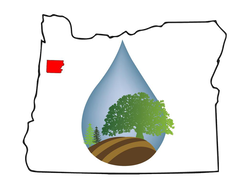|
|
|
|
With the conclusion of the North Willamette Valley Upland Oak Restoration Program, the Polk SWCD and local NRCS offices have coordinated to continue more Oak habitat work to continue to meet the sustained demand for more Oak habitat restoration in Polk County.
This ‘Meadow Restoration Polk Phase 1’ program aims to restore meadows and wildlife corridors to improve the health and diversity of declining habitat types to benefit target species. These meadows are declining habitats throughout Polk County, primarily due to conifer encroachment, delayed management of dense woodlands, and increased agricultural and urban development. Food, cover, and shelter in lower elevation oak meadows and upper elevation conifer meadows is inadequate to support Roosevelt elk, black-tailed deer, Fender’s blue butterflies, monarch butterflies, and grassland birds. Restoration will benefit native ungulate populations and a myriad of non-game species of conservation concern (including several federally listed threatened and endangered species), rare and declining plants/plant communities, invertebrates, reptiles, and numerous species of grassland and oak associated migratory birds. The Phase 1 roll-out of this program includes the northern portion of Polk County and partially into Yamhill County.
Funding comes through the USDA’s NRCS offices and is managed by the Polk SWCD’s certified planners. Landowners with oak habitats in Polk and Yamhill County have an opportunity to participate in voluntary conservation to improve existing oak habitat, using the NRCS’ Environmental Quality Incentives Program (EQIP). NRCS provides financial and technical assistance to landowners to implement practices on their land and ensure the long-term health of oak habitat. By implementing various conservation measures and controlling invasive species, landowners can enhance wildlife habitat resources to create more valuable habitat, manage invasive species more efficiently and create properties that can be considered for long-term protection by a variety of funders. If you have oak woodland, oak savanna, or open prairie habitat types on a property you manage, please contact us to find out more about how to take advantage of funding for restoring these habitat types.
This ‘Meadow Restoration Polk Phase 1’ program aims to restore meadows and wildlife corridors to improve the health and diversity of declining habitat types to benefit target species. These meadows are declining habitats throughout Polk County, primarily due to conifer encroachment, delayed management of dense woodlands, and increased agricultural and urban development. Food, cover, and shelter in lower elevation oak meadows and upper elevation conifer meadows is inadequate to support Roosevelt elk, black-tailed deer, Fender’s blue butterflies, monarch butterflies, and grassland birds. Restoration will benefit native ungulate populations and a myriad of non-game species of conservation concern (including several federally listed threatened and endangered species), rare and declining plants/plant communities, invertebrates, reptiles, and numerous species of grassland and oak associated migratory birds. The Phase 1 roll-out of this program includes the northern portion of Polk County and partially into Yamhill County.
Funding comes through the USDA’s NRCS offices and is managed by the Polk SWCD’s certified planners. Landowners with oak habitats in Polk and Yamhill County have an opportunity to participate in voluntary conservation to improve existing oak habitat, using the NRCS’ Environmental Quality Incentives Program (EQIP). NRCS provides financial and technical assistance to landowners to implement practices on their land and ensure the long-term health of oak habitat. By implementing various conservation measures and controlling invasive species, landowners can enhance wildlife habitat resources to create more valuable habitat, manage invasive species more efficiently and create properties that can be considered for long-term protection by a variety of funders. If you have oak woodland, oak savanna, or open prairie habitat types on a property you manage, please contact us to find out more about how to take advantage of funding for restoring these habitat types.
You will need to be eligible to receive assistance funding from USDA. Please use the following fact sheet to help determine your eligibility.
To learn more about the application process please take a look at the NRCS’s EQIP page.
To learn more about the application process please take a look at the NRCS’s EQIP page.

